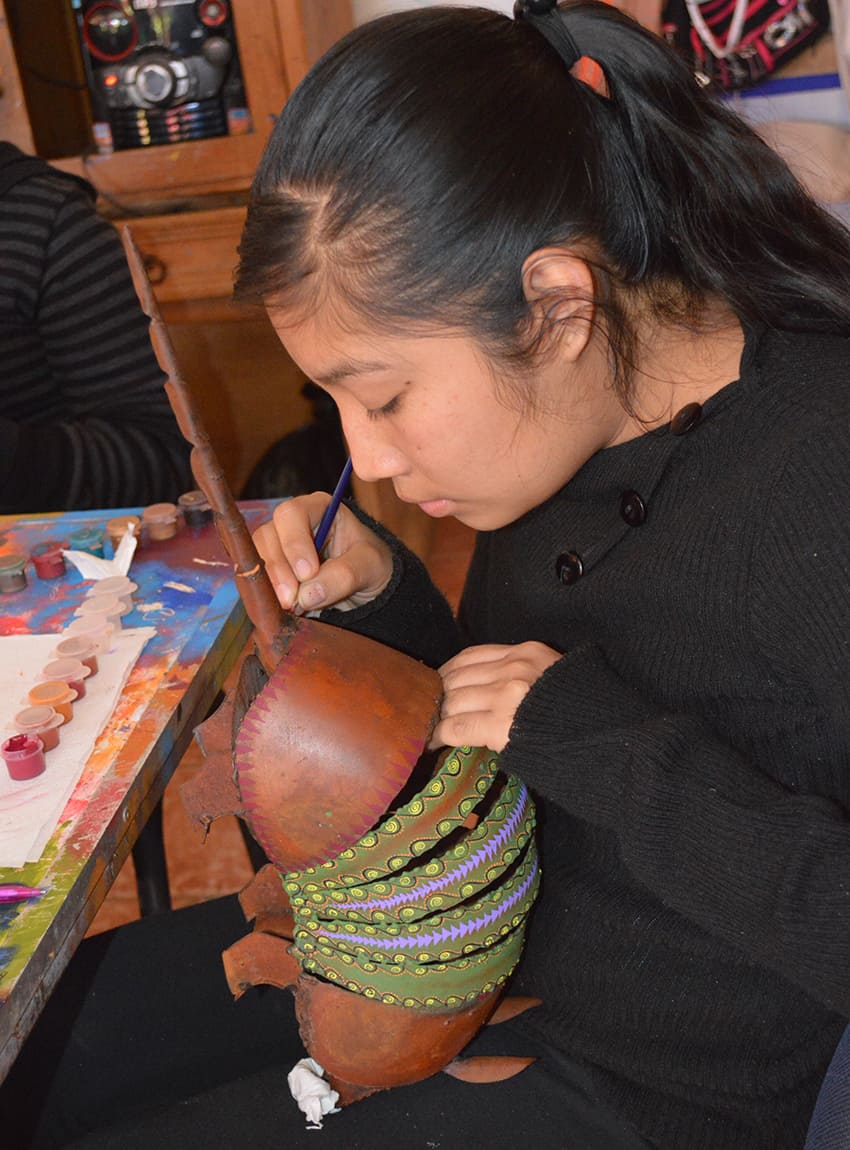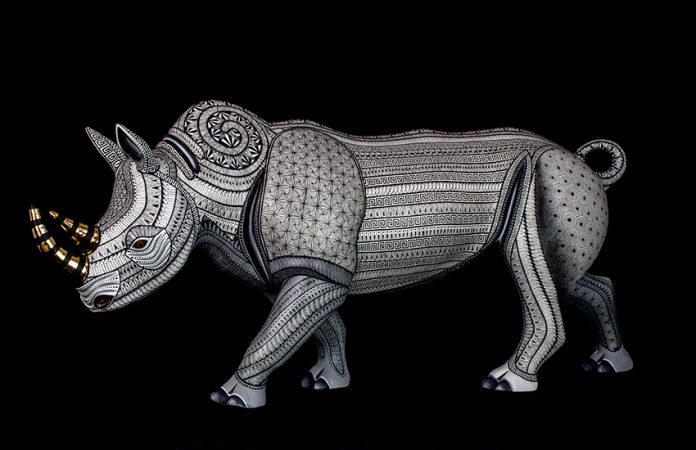The workshop of Jacobo and María del Carmen Ángeles is by far one of the best-developed production and sales operations of any traditional handcraft maker. In fact, they could just simply be called San Martín Tilcajete, Inc.
The workshop in this small village in the Central Valleys of Oaxaca began like most: Jacobo Ángeles Ojeda was born in the town of Tilcajete in 1973 and is known for the making of colorful animal wood carvings called alebrijes (sometimes called tonas — see this article for the debate surrounding this craft).
Both he and his wife María del Carmen Mendoza grew up in families dependent on subsistence farming, with Ángeles’ father teaching him how to carve the local copal wood. Over time, Ángeles became one of several outstanding alebrije artisans, in particular for painting of fine lines and designs based on Zapotec and other indigenous imagery. However, he credits his wife for most of the designs.
The couple found that they could leave farming behind and concentrate on alebrije making. Demand rose so much that they began to hire other family members and neighbors to work in their shop. By the time I visited them for the first time in 2016, the family compound was humming with activity, carvers in one area and painters in another, as well as areas dedicated to demonstrating the process of making the capricious figures, even including the making of paints for the alebrijes using local pigments.
The maestro still carves pieces on occasion, which command premium prices. But the vast majority of the production is done by employees, students/apprentices and other collaborators, supervised by members of the family, which is currently a major employer in the town, with generations of various families working for them.

Although not directly by the maestros’ hands, the pieces are still of high quality as the family trains carvers and painters, then lets them utilize their talents to take the best advantage of copal wood’s capricious nature. The workshop produces some alebrijes with human faces, belying their link to naguals (somewhat like a spirit animal), but many depict jaguars, dogs, bears, owls and other local creatures, often in motion.
The Ángeles family’s work has been recognized, with their alebrijes appearing in major museums in Mexico and the United States, including the Museo de Arte Popular in Mexico City (which published a book featuring their work) and the Smithsonian Institution’s National Museum of the American Indian. In 2014, Jacobo Ángeles was invited by the Vatican to create an alebrije nativity and meet Pope Francis.
But the Ángeles family is not content to sit on its laurels. When I was there in 2016, they were building additions to the compound’s buildings and talking about plans for expansion and diversification.
One thing that sets this family and business apart is their awareness of how crucial the local and state economy is to the continued success of their business. In particular, they understand that they need to nurture tourism in San Martín Tilcajete and the surrounding valley. This began by offering tours and workshops for visitors, including some in English.
After that, they began working to make San Martín a tourist destination in its own right, at least as a side trip from the city of Oaxaca. This included the opening of three restaurants in the town, all based on local cuisine but with different interpretations. The basic foodstuffs of these restaurants are mostly supplied by their own farms or other local ones.
In 2020, Jacobo and María, seeking even more awareness of their workshop and community, ingeniously connected with the Mercedes-Benz company, which provided them with an SUV to paint alebrije-style and documented the entire process and the finished product online.

Oaxaca’s main attraction is its various cultures, and the Ángeles family has looked for ways to promulgate the Ocotán Valley’s cultures for its economic development. Their son Ricardo grew up making alebrijes but went on to study art in Oaxaca and Mexico City. He has translated these creatures (and the nagual tradition behind them) into mural projects, which work to bring visitors into towns and into parts of towns they might not have wandered otherwise. His work can be seen on Instagram.
The family has realized, however, that the making of alebrijes, though successful now, is not sufficient. And so the Ángeles family has trained extended family members and other locals how to carve for a long time, leading to a kind of apprenticeship program. They also offer classes and workshops in ceramics and jewelry making, including a class for children, inviting maestros of these crafts to be the instructors.
The vast array of economic and cultural activities promoted by the family really deserves its own future article. But it is important to note that these enterprises employed about 300 people directly before the pandemic struck, including carvers, painters, restaurant workers, arborists and professionals in marketing and sustainable development. That number is now 160, but the family sees a slow rebound in tourism and hopes to bring employment back to pre-Covid levels soon.
Their business sense has allowed them to weather the pandemic better, in part because they already had an online presence. Although sales have still been cut in half, online marketing has been a lifeline, it relying strongly on their website and various Instagram accounts.
While they most assuredly look forward to resuming business as much as possible to the way it was before the pandemic, the Ángeles family is definitely a pioneer in the online marketing of Oaxacan crafts.
Leigh Thelmadatter arrived in Mexico 18 years ago and fell in love with the land and the culture in particular its handcrafts and art. She is the author of Mexican Cartonería: Paper, Paste and Fiesta (Schiffer 2019). Her culture column appears regularly on Mexico News Daily.
